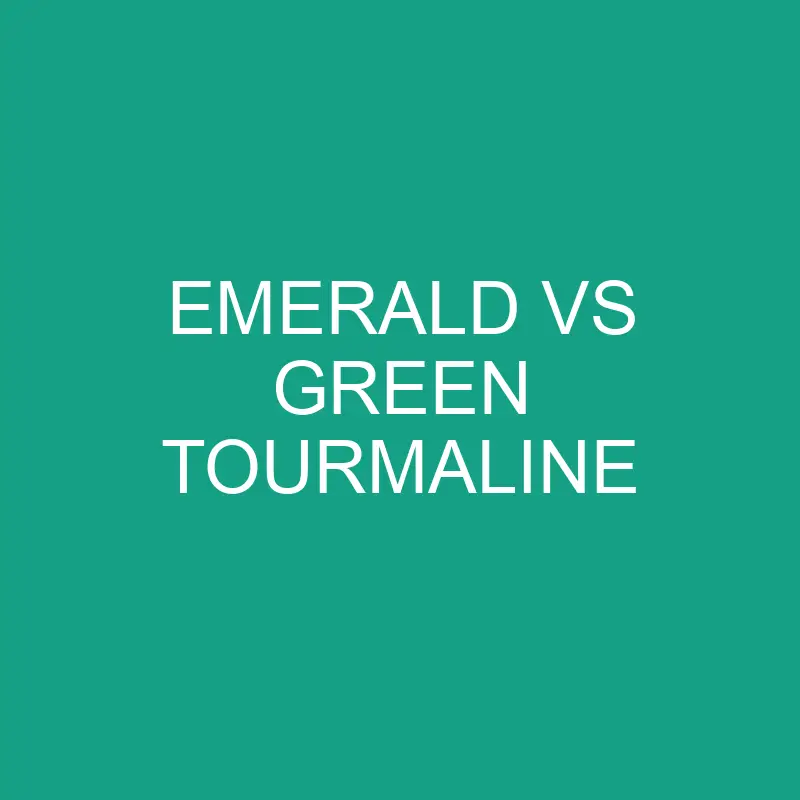Green gemstones have long captured the imagination and admiration of jewelry enthusiasts, and two notable members of this category are Emerald and Green Tourmaline. While both exhibit captivating green hues, these gemstones differ in various aspects, including their geological origins, physical properties, and cultural significance. In this comprehensive exploration, we will delve into the characteristics, origins, uses, and metaphysical properties of Emerald and Green Tourmaline.
Post Contents
Emerald: The Enchanting Green Gemstone
Origins and Geological Background:
- Composition: Emerald is a variety of the mineral beryl, and its green color comes from the presence of chromium and vanadium.
- Color: The most prized emerald color is a deep, rich green, often described as “emerald green.”
- Formation: Emeralds are typically found in metamorphic rocks, and their formation involves a combination of heat and pressure.
Physical Properties:
- Color and Appearance: Emeralds range in color from light green to deep green, and their appearance may include inclusions, known as “jardin” or garden.
- Transparency: They are usually transparent to translucent.
- Crystal Structure: Emeralds belong to the hexagonal crystal system.
- Luster: They exhibit a vitreous luster.
- Hardness: Emeralds have a hardness of 7.5 to 8 on the Mohs scale.
Origins and Mining:
- Locations: Major sources of emeralds include Colombia, Zambia, Brazil, and Zimbabwe.
- Mining: Emeralds are often extracted from mines using traditional mining methods.
Cultural Significance:
- Historical Use: Emeralds have been valued throughout history and were used by ancient civilizations for jewelry, including by the Egyptians and the Incas.
- Symbolism: Emeralds are associated with rebirth, fertility, and love. They are often considered a symbol of hope and renewal.
Green Tourmaline: The Vivid Green Tourmaline Gemstone
Origins and Geological Background:
- Composition: Green Tourmaline, also known as Verdelite, is a variety of the mineral tourmaline. Its color is influenced by the presence of iron.
- Color: Green Tourmaline comes in various shades of green, from light to dark green.
- Formation: Tourmalines are typically found in granite and pegmatite rocks.
Physical Properties:
- Color and Appearance: Green Tourmalines can range from a pale green to a deep forest green. They may have a variety of inclusions or be free of visible inclusions.
- Transparency: They are usually transparent.
- Crystal Structure: Tourmalines have a trigonal crystal structure.
- Luster: Green Tourmalines exhibit a vitreous to sometimes resinous luster.
- Hardness: They have a hardness of 7 to 7.5 on the Mohs scale.
Origins and Mining:
- Locations: Green Tourmalines are found in various locations, including Brazil, Afghanistan, Namibia, and the United States.
- Mining: They are often mined from pegmatite deposits using both traditional and modern mining methods.
Cultural Significance:
- Historical Use: Tourmalines, including the green variety, have been used historically in jewelry. They gained popularity in the 18th century when they were brought to Europe from Sri Lanka.
- Symbolism: Green Tourmalines are associated with qualities such as joy, abundance, and vitality. They are believed to enhance spiritual growth.
Comparative Analysis: Emerald vs. Green Tourmaline
Color and Appearance:
- Emerald: Ranges from light to deep green, often with inclusions.
- Green Tourmaline: Comes in various shades of green, with a range of inclusions or sometimes no visible inclusions.
Transparency:
- Emerald: Usually transparent to translucent.
- Green Tourmaline: Generally transparent.
Crystal Structure:
- Emerald: Hexagonal crystal structure.
- Green Tourmaline: Trigonal crystal structure.
Luster:
- Emerald: Exhibits a vitreous luster.
- Green Tourmaline: Displays a vitreous to sometimes resinous luster.
Hardness (Mohs Scale):
- Emerald: 7.5 to 8.
- Green Tourmaline: 7 to 7.5.
Origins and Mining:
- Emerald: Major sources include Colombia, Zambia, Brazil, and Zimbabwe. Mined using traditional methods.
- Green Tourmaline: Found in various locations, including Brazil, Afghanistan, Namibia, and the United States. Mined from pegmatite deposits.
Cultural Significance:
- Emerald: Historically valued and associated with rebirth, fertility, and love.
- Green Tourmaline: Gained popularity in the 18th century, associated with joy, abundance, and vitality.
Uses in Jewelry and Art:
Emerald:
- Jewelry: Emeralds are highly sought after for jewelry, including rings, necklaces, and earrings. They are often cut into faceted gemstones or cabochons.
- Carvings and Decor: Emeralds have been historically used for carved objects and decorative items.
Green Tourmaline:
- Jewelry: Green Tourmalines are popular choices for jewelry, especially in rings and earrings. They are often faceted or cut into cabochons.
- Carvings and Decor: While not as commonly used in carvings, Green Tourmalines are appreciated for their vibrant color in artistic creations.
Metaphysical Properties: Emerald vs. Green Tourmaline
Emerald:
- Heart Chakra: Associated with the heart chakra, promoting love, compassion, and emotional healing.
- Clarity and Intuition: Believed to enhance mental clarity and intuition.
- Balance: Emeralds are thought to bring balance and harmony to the wearer.
Green Tourmaline:
- Heart Chakra: Like Emerald, Green Tourmaline is associated with the heart chakra and is believed to promote love and emotional healing.
- Vitality: It is thought to bring vitality and joy, enhancing one’s energy and enthusiasm for life.
- Spiritual Growth: Green Tourmaline is associated with spiritual growth and a deeper connection to nature.
Conclusion: Emerald vs. Green Tourmaline
In the realm of green gemstones, Emerald and Green Tourmaline each bring their unique characteristics and energies. Emerald, with its rich history, deep green color, and association with love and rebirth, remains a classic and coveted gemstone. Green Tourmaline, with its vibrant and varied shades of green, is prized for its joyful energy, vitality, and connection to nature.
Choosing between Emerald and Green Tourmaline often depends on personal preferences, the specific color desired, and the metaphysical properties one seeks. Whether adorning oneself with the lush green of an Emerald or the lively hues of a Green Tourmaline, both gemstones contribute
